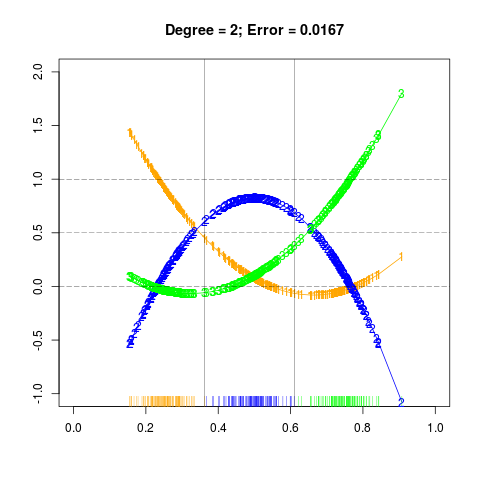模拟:Fig. 4.3¶
| 正文 | 4.3 线性判别分析 |
|---|---|
| 作者 | szcf-weiya |
| 发布 | 2018-07-11 |
生成数据¶
根据 Fig. 4.2 知,我们需要生成三个类别的数据,于是采用下面代码生成了均值不同,协方差相同的多元正态随机变量,
mu = c(0.25, 0.5, 0.75)
sigma = 0.005*matrix(c(1, 0,
0, 1), 2, 2)
library(MASS)
set.seed(1650)
N = 100
X1 = mvrnorm(n = N, c(mu[1], mu[1]), Sigma = sigma)
X2 = mvrnorm(n = N, c(mu[2], mu[2]), Sigma = sigma)
X3 = mvrnorm(n = N, c(mu[3], mu[3]), Sigma = sigma)
X = rbind(X1, X2, X3)
分布图为

拟合¶
首先将生成的数据投射到三类数据点形心连线上,并且构造响应变量 $y$,然后分别拟合左右图,并以此进行分类,计算误差率,具体结果如下:
左图¶
## project X onto the line joining the three centroids
X.proj = rowMeans(X) # if necessary, multiply sqrt 2
## fit as in figure 4.3
## consider orange
Y1 = c(rep(1, N), rep(0, N*2))
## blue
Y2 = c(rep(0, N), rep(1, N), rep(0, N))
## green
Y3 = c(rep(0, N), rep(0, N), rep(1, N))
## regression
m1 = lm(Y1~X.proj)
pred1 = as.numeric(fitted(m1)[order(X.proj)])
m2 = lm(Y2~X.proj)
pred2 = as.numeric(fitted(m2)[order(X.proj)])
m3 = lm(Y3~X.proj)
pred3 = as.numeric(fitted(m3)[order(X.proj)])
c1 = which(pred1 <= pred2)[1]
c2 = min(which(pred3 > pred2))
# class 1: 1 ~ c1
# class 2: c1+1 ~ c2
# class 3: c2+1 ~ end
# actually, c1 = c2
err1 = (abs(c2 - 2*N) + abs(c1 - N))/(3*N)
## Alternative method
cl = numeric(3*N)
for (i in 1:(3*N))
{
cl[i] = which.max(c(pred1[i], pred2[i], pred3[i]))
}
truth = c(rep(1, N), rep(2, N), rep(3, N))
err1 = sum(cl - truth != 0) / (3*N)
## reproduce figure 4.3 left
png("reproduce-fig-4-3l.png")
plot(0, 0, type = "n",
xlim = c(0, 1), ylim = c(0,1), xlab = "", ylab = "",
main = paste0("Degree = 1; Error = ", round(err1, digits = 4)))
abline(coef(m1), col = "orange")
abline(coef(m2), col = "blue")
abline(coef(m3), col = "green")
points(X.proj, fitted(m1), pch="1", col="orange")
points(X.proj, fitted(m2), pch = "2", col = "blue")
points(X.proj, fitted(m3), pch = "3", col = "green")
rug(X.proj[1:N], col = "orange")
rug(X.proj[(N+1):(2*N)], col = "blue")
rug(X.proj[(2*N+1):(3*N)], col = "green")
abline(h=c(0.0, 0.5, 1.0), lty=5, lwd = 0.4)
abline(v=c(sort(X.proj)[N], sort(X.proj)[N*2]), lwd = 0.4)
dev.off()

右图¶
## polynomial regression
pm1 = lm(Y1~X.proj+I(X.proj^2))
pm2 = lm(Y2~X.proj+I(X.proj^2))
pm3 = lm(Y3~X.proj+I(X.proj^2))
## error rate for figure 4.3 right
pred21 = as.numeric(fitted(pm1)[order(X.proj)])
pred22 = as.numeric(fitted(pm2)[order(X.proj)])
pred23 = as.numeric(fitted(pm3)[order(X.proj)])
c1 = which(pred21 <= pred22)[1] - 1
c2 = max(which(pred23 <= pred22))
# class 1: 1 ~ c1
# class 2: c1+1 ~ c2
# class 3: c2+1 ~ end
err2 = (abs(c2 - 2*N) + abs(c1 - N))/(3*N)
## reproduce figure 4.3 right
png("reproduce-fig-4-3r.png")
plot(0, 0, type = "n",
xlim = c(0, 1), ylim = c(-1,2), xlab = "", ylab = "",
main = paste0("Degree = 2; Error = ", round(err2, digits = 4)))
lines(sort(X.proj), fitted(pm1)[order(X.proj)], col="orange", type = "o", pch = "1")
lines(sort(X.proj), fitted(pm2)[order(X.proj)], col="blue", type = "o", pch = "2")
lines(sort(X.proj), fitted(pm3)[order(X.proj)], col="green", type = "o", pch = "3")
abline(h=c(0.0, 0.5, 1.0), lty=5, lwd = 0.4)
## add rug
rug(X.proj[1:N], col = "orange")
rug(X.proj[(N+1):(2*N)], col = "blue")
rug(X.proj[(2*N+1):(3*N)], col = "green")
abline(v=c(sort(X.proj)[N], sort(X.proj)[N*2]), lwd = 0.4)
dev.off()

完整代码参见 Github